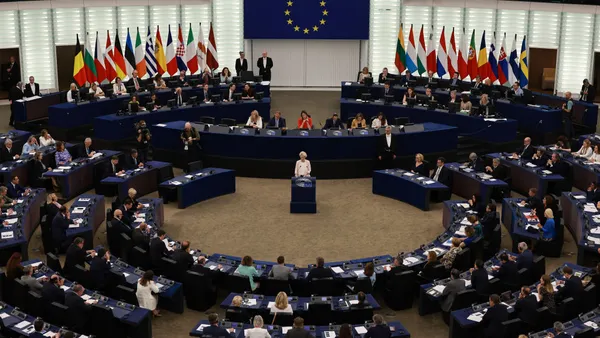Leading up to the presidential election, Donald Trump campaigned vehemently against free trade deals, claiming they were bad for American jobs, manufacturing and the economy.
Businesses grew concerned about the rhetoric, worrying what the dismantling of free trade deals could mean for their imports, exports and supply chains. In 2017, protectionist trade policy became the top business concern in the apparel and fashion industry — a drastic increase over the figures in 2016.
The first tariffs were announced in January 2018 on imports of solar panels. But that escalated quickly, to tariffs on billions of dollars of goods among the world’s largest trading partners.
So how did we get here? See the timeline below, or click to filter tariffs by country. We’ll continue to update this list as more news becomes available.
Tariff Timeline
-
Feb 7
China to slash tariffs by 50% on $75B of US imports
The changes will take effect Feb. 14, and the move follows the Trump administration's announcement during the signing of a phase one trade deal to reduce the tariff rate from 15% to 7.5% on Feb. 14 on about $120 billion worth of imports from China.

-
Dec 23
China to lower tariffs on hundreds of products Jan. 1
Chinese trade authorities will lower tariffs on imported frozen pork, frozen avocados, non-frozen orange juice, wood and paper products and some components for high-tech electronics.

-
Dec 13
Trump cancels Dec. 15 China tariffs
U.S. tariffs on Chinese goods slated to take effect Dec. 15, known as list 4B, will not take effect, and the 15% tariffs that took effect at the beginning of September on about $120 billion worth of goods (list 4A) will be reduced to a rate of 7.5%.

-
Oct 11
Trump calls off Oct. 15 tariff increases
The U.S. will hold off on the tariff hikes originally scheduled for Oct. 15. The tariffs were set to go from 25% to 30% on $250 billion in Chinese imports.

-
Sep 11
Trump: US will delay Oct. 1 tariff increase on Chinese goods by 2 weeks
The U.S. Trade Representative announced plans last month to increase the existing 25% tariff on $250 billion worth of Chinese goods to a rate of 30% on Oct. 1. This is now delayed until Oct. 15.

-
Aug 23
US to up all China tariffs 5 percentage points
The U.S. will increase the tariff rate on the remaining $300 billion worth of imports from China to 15%. The USTR will begin the process of raising the existing 25% tariff on $250 billion worth of Chinese goods to a rate of 30% on Oct. 1

-
Aug 23
China to add tariffs on $75B of US imports
Some of the duties will take effect Sept. 1 and others Dec. 15, mirroring the U.S. schedule of tariffs on China.

-
Aug 13
USTR: 10% tariffs on 'certain' clothing, electronics from China delayed to Dec. 15
Some electronics, apparel and footwear will not face tariffs until December. "We’re doing this for the Christmas season," Trump told reporters.

-
Aug 1
Trump: US to impose 10% tariffs on $300B in Chinese goods
The tariffs will take effect on Sept. 1, and negotiations will continue in early September.

-
July 1
US proposes tariffs on $4B EU imports
The latest duties comprise a supplemental list, adding on to tariffs proposed in April on $21 billion worth of goods, covering several food products and whiskey.

-
June 29
Trump: US won't impose tariffs on $300B Chinese goods 'for the time being'
Trump said the U.S. and China agreed to resume trade negotiations, and China will buy a "tremendous amount" of food and agricultural products from the U.S.

-
June 7
US to 'indefinitely' suspend Mexico tariffs
President Donald Trump said, via tweet, the 5% tariffs, originally set to take effect Monday, June 10, are "hereby indefinitely suspended."

-
May 30
US announces tariffs on all imports from Mexico starting June 10
Tariffs on Mexico throw a wrench into what seemed to be smooth sailing for ratification of the USMCA.

-
May 17
US lifts steel, aluminum tariffs on Canada, Mexico
The 25% tariffs on Canadian and Mexican steel and 10% on aluminum, in place since March 2018, were major barriers to the ratification of the United States, Mexico and Canada Agreement (USMCA).


-
May 13
US formally begins process for tariffs on $300B
The list includes raw materials and finished goods across dozens of industries, touching nearly every U.S. business — and in turn, every consumer.

-
May 13
China will raise the tariff rate on $60 billion worth of US imports beginning June 1
Higher duties on animal and food products could make U.S. exports of these goods less appealing to Chinese buyers, creating even higher stockpiles for farmers and lowered prices.

-
May 10
US begins the process for tariffs on all remaining Chinese imports
Implementing tariffs on the remaining $300 billion worth of goods from China would affect nearly every industry that imports anything from China, from a small component to a finished product.

-
May 8
China threatens 'necessary' retaliation to tariff hike
Economists say retaliatory tariffs from China likely won't have a significant effect on the U.S. economy due to the trade imbalance, but agriculture could take a hit.

-
May 5
Trump: Tariffs on $200B Chinese imports will rise to 25% Friday
U.S. Trade Representative Robert Lighthizer confirmed the news the following day, after Trump tweeted about the tariff hike Sunday night.

-
April 8
US proposes tariffs on $11B of EU imports
The preliminary list includes a wide variety of goods, including helicopters, food items such as seafood and cheese, wine, apparel and minerals.

-
February 24
Trump delays tariff hike initially scheduled for March
Tariffs on $200 billion worth of imports from China will remain at 10%, and the President plans to meet with Chinese President Xi Jinping "to conclude an agreement," Trump tweeted.

-
December 1
US, China agree to delay Jan. 1 tariff hike
Tariffs on $200 billion worth of imports from China will remain at a rate of 10%, as the two nations' leaders negotiate "structural changes" over the next 90 days.

-
September 17
Tariffs on $200B worth of imports from China start Sept. 24
The duties will start at 10% and rise to 25% at the beginning of 2019.

-
August 7
US to collect 25% duties on $16B Chinese imports starting Aug. 23
The tariffs follow a first round of taxes on $34 billion of imports from China that began July 6, bringing the total to $50 billion.

-
August 3
China warns it could retaliate with tariffs on $60B
China's announcement came after President Donald Trump recommended increasing proposed duties on $200 billion worth of Chinese imports to 25%, up from 10% announced in July

-
July 25
US, EU vow to work toward 'zero tariffs'
After a meeting between President Donald Trump and President of the EU Commission Jean-Claude Juncker, the two released a joint statement agreeing set up a working group to lower trade barriers.

-
July 10
US announces tariffs on $200B more goods from China
The announcement came in response to China's retaliatory tariffs on $34 billion of U.S. goods. China promise "firm and forceful measure in return," but the country has only about $80 billion of U.S. imports remaining to tax.

-
July 6
US, China hit each other with $34B in tariffs
The U.S. imposed 25% duties on $34 billion worth of Chinese imports, and China retaliated swifty with tariffs of equal measure. China’s Commerce Ministry said the U.S. has "ignited the largest trade war in economic history."

-
June 15
India, China retaliate against US tariffs
China announced Friday it would impose a 25% tariff on 545 U.S. products worth $34 billion, a reciprocal response to the U.S. action against 818 Chinese products announced that same day.

-
May 31
US allies retaliate against 'unacceptable' steel tariffs
In response to steel and aluminum tariffs, Canada announced tariffs on $12.8 billion in US products, and Mexico declared it would place duties on steel along with other products, totaling $3 billion. The European Union called it a "bad day for world trade."



-
May 31
US moves forward with steel tariffs on EU, Canada, Mexico
The U.S. let tariff exemptions expire, resulting in duties of 25% on steel and 10% on aluminum for Canada, Mexico and the European Union.



-
May 29
US slaps 25% tariff on $50B of Chinese imports
The tariffs cover "industrially significant technology” and are aimed to punish China for intellectual property abuses.

-
May 20
US pauses trade war with China
Treasury Secretary Steven Mnuchin told Fox News that the U.S. was "putting the trade war on hold."

-
April 30
US delays steel, aluminum tariffs until June
Tariffs on steel and aluminum imports from Canada, Mexico and the European Union were set to take effect May 1, but the Trump administration granted a 30-day exemption.



-
April 2
China puts tariffs on $3B worth of selected US food exports
In retaliation for steel and aluminum tariffs, China imposed duties between 15% and 25% on more than 128 products, including several food and agricultural products.

-
March 22
US announces tariffs on up to $60B in goods imported from China
This announcement marked the first tariffs during Trump’s administration targeted directly at China, sparking fears of a trade war among retail and tech industry leaders.

-
March 8
Trump slaps on steel tariffs but spares NAFTA neighbors
Trump signed proclamations imposing a 25% tariff on five classifications of steel articles and a 10% tariff on six types of aluminum products against all countries but Canada and Mexico, effective March 23, 2018.


-
March 2
EU threatens retaliatory tariffs on Levi's jeans and bourbon
The tariff threats came in retaliation to U.S. tariffs on steel and aluminum and target $3.5B in imports to the EU.

-
March 1
Trump say he’ll put 25% tariffs on steel and 10% on aluminum
Donald Trump said U.S. manufacturing industries had been "decimated" by unfair trade policies.




-
Jan 22
Trump issues 30% tariff on solar imports
Two U.S. solar manufacturers petitioned for import relief, blaming low-price imports, mostly from Chinese companies based in other countries, for their predicament.




Other Key Coverage
- 10% China tariffs and the supply chain scramble
- How to navigate the 90-day tariff 'cease-fire'
- What the trade war with China means for retail's pre-holiday
- 15 unexpected tariffs from US allies
- Trump, tariffs, trade wars and tech: What you need to know
- Supply chains of steel: How tariffs will disrupt downstream manufacturing












